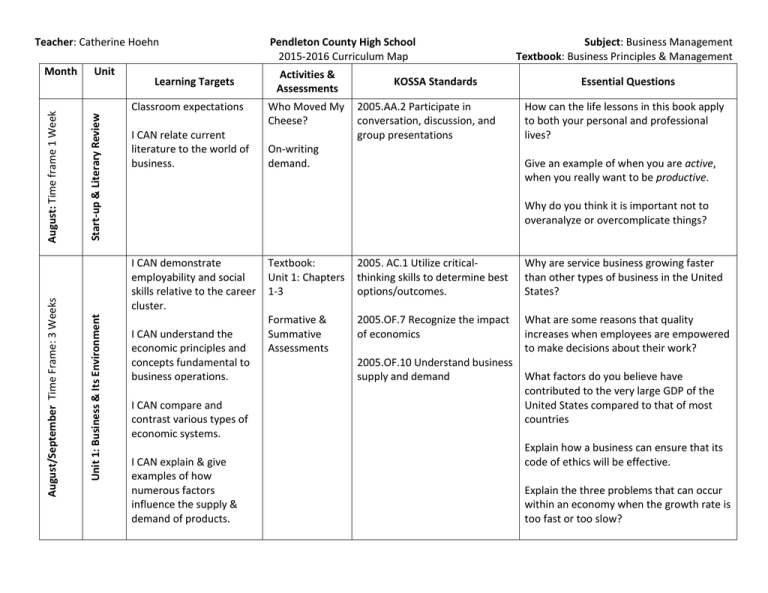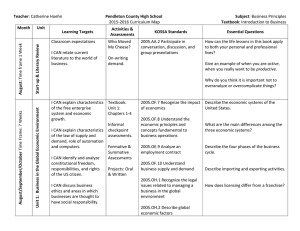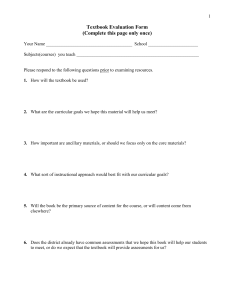Teacher: Catherine Hoehn Pendleton County High School Subject
advertisement

Teacher: Catherine Hoehn Unit Learning Targets Start-up & Literary Review Classroom expectations I CAN relate current literature to the world of business. Activities & Assessments Who Moved My Cheese? KOSSA Standards 2005.AA.2 Participate in conversation, discussion, and group presentations On-writing demand. Subject: Business Management Textbook: Business Principles & Management Essential Questions How can the life lessons in this book apply to both your personal and professional lives? Give an example of when you are active, when you really want to be productive. Why do you think it is important not to overanalyze or overcomplicate things? I CAN demonstrate employability and social skills relative to the career cluster. Unit 1: Business & Its Environment August/September Time Frame: 3 Weeks August: Time frame 1 Week Month Pendleton County High School 2015-2016 Curriculum Map I CAN understand the economic principles and concepts fundamental to business operations. I CAN compare and contrast various types of economic systems. I CAN explain & give examples of how numerous factors influence the supply & demand of products. Textbook: Unit 1: Chapters 1-3 2005. AC.1 Utilize criticalthinking skills to determine best options/outcomes. Why are service business growing faster than other types of business in the United States? Formative & Summative Assessments 2005.OF.7 Recognize the impact of economics What are some reasons that quality increases when employees are empowered to make decisions about their work? 2005.OF.10 Understand business supply and demand What factors do you believe have contributed to the very large GDP of the United States compared to that of most countries Explain how a business can ensure that its code of ethics will be effective. Explain the three problems that can occur within an economy when the growth rate is too fast or too slow? Teacher: Catherine Hoehn Pendleton County High School 2015-2016 Curriculum Map Subject: Business Management Textbook: Business Principles & Management I CAN compare and contract various forms of competition. Unit Unit 2: Business Ownership and the Law September Time Frame: 3 Weeks Month Learning Targets Activities & Assessments KOSSA Standards Essential Questions I CAN research various structures of business ownership. Textbook: Unit 2: Chapters 5-7 2005.AA.3 Communicate and follow directions/procedures Explain why a large business would want to have an employee with entrepreneurial skills. I CAN explain considerations in business planning, including advantages and disadvantages of each structure. Compare & Contrast graphic 2005. EG.4 Locate and verify organizer. information. I CAN describe the formation of a corporation. I CAN utilize SWOT analysis when analyzing case studies and business plans. I CAN research and cite major laws/regulations that affect management and examine the importance of work ethics. Case Studies What Would you do? (Selfreflection writing) Formative & Summative Assessments 2005. OB.1 Compare forms of business ownership. 2005. OB.3 Identify the factors that influence an organization’s structure. 2005. OK.1 Review and evaluate a sample business plan. 2005.OF.5 Utilize SWOT (Strengths, Weaknesses, Opportunities, and Threats) analysis with case studies/business plan 2005.AC.1 Utilize critical-thinking skills to determine best options/outcomes Explain the advantages of being a limited partner in a company. Describe the steps a company must take to become a corporation. List the basic right of stockholders. Identify the types of businesses that would benefit from a corporate form of ownership. List the major disadvantages of the corporate form of business. Teacher: Catherine Hoehn Unit Learning Targets I CAN identify and explain basic functions of management, management styles, and criteria used in settings and achieving goals. I CAN discuss how global issues and international trade has and will affect management types, styles, and trends. I CAN utilize SWOT analysis when analyzing case studies and business plans. I CAN research and analyze career opportunities in management and demonstrate leadership characteristics. I CAN develop an employment portfolio and demonstrate leadership characteristics. Subject: Business Management Textbook: Business Principles & Management Essential Questions Textbook: Unit 4: Chapters 11-14 2005. AC.1 Utilize critical-thinking skills to determine best options/outcomes. How is a supervisor’s work different from the work of mid-managers and executives? Case Studies 2005. EG.4 Locate and verify information. What can employees do both on and off the job to prepare themselves to be effective managers? Group Work Unit 3: Management Responsibilities September, October, November, December: Time Frame 11 weeks Month Pendleton County High School 2015-2016 Curriculum Map Activities & KOSSA Standards Assessments Oral Presentations Formative & Summative Assessments 2005. OB.2 Describe types of organizational structures and management levels. 2005. OB.3 Identify the factors that influence an organization’s structure. 2005. OB.4 Construct an organizational chart. 2005. OC.1 Discuss the importance of vision, mission, goals, and objectives within the context of the business environment. 2005. OC.2 Discuss characteristics of effective and ineffective leaders. 2005. OC.3 Differentiate between leading and managing. 2005. OC.4 Compare and contrast leadership styles. 2005. OC.5 Demonstrate an understanding of the four functions If a school was facing a problem with students being tardy for classes, how could the school use one of the TQM tools to help solve that problem? What should managers ask what-if questions when developing plans? Which of the human relations skills do you believe are most important for a manager in working with employees? Justify your answer. As a supervisor, which leadership style would work best for you? How can a clear and meaningful vision and mission statement help increase employee motivation and enthusiasm for a business plan? How do you believe a manager should involve employees in planning for a change that will result in some of the employees losing their jobs? Teacher: Catherine Hoehn Pendleton County High School 2015-2016 Curriculum Map Subject: Business Management Textbook: Business Principles & Management of management: planning, Do you believe managers should perform organizing, leading, and controlling. each of the management functions in order? Why or why not? 2005. OC.6 Identify and discuss management theories. 2005. OD.7 Describe why different managerial styles can be equally successful. 2005. AA.1 Utilize effective verbal and non-verbal communication skills. Month Unit Learning Targets Unit 4: Literary Review January Time Frame: 2 weeks I CAN relate current literature to the world of business. I CAN demonstrate employability and social skills relative to the career cluster. Activities & Assessments One Minute Manager On-writing demand. KOSSA Standards 2005.AA.2 Participate in conversation, discussion, and group presentations Explain the meaning of the statement “Planning is usually not exact” as it applies to evaluating performance and standards. Describe several ways that managers can reduce costs in the business by paying attention to areas where costs are often high. Essential Questions How can the techniques learned in this book apply to both your personal and profession lives? What expectations would you have of your current or future managers? Teacher: Catherine Hoehn Unit Unit 5: Human Resources Management January, February Time Frame: 4 weeks Month Learning Targets Pendleton County High School 2015-2016 Curriculum Map Activities & KOSSA Standards Assessments Subject: Business Management Textbook: Business Principles & Management Core Content & DOK I CAN explain the importance of various business management skills in the business environment. Textbook: Unit 7: Chapters 23-25 2005.AA.1 Utilize effective verbal and non-verbal communication skills What are some possible advantages and disadvantages of using a 360-degree system for performance evaluation? Problem Solving 2005.AA.3 Communicate and follow directions/procedures If you were a businessperson, how would you respond to the ADA requirements? I CAN analyze how the impact of human resource management activities help organizations achieve goals. Job Applications, Resumes, & Interviews. 2005.AA.4 Communicate effectively with customers and co-workers List the important laws that regulate employment discrimination and equal employment. Oral Presentations 2005.AB.1 Locate and interpret written information List several factors that should be considered by a company when establishing a compensation plan. Formative & Summative Assessments 2005.AB.2 Read and interpret workplace documents I CAN apply math, communication, and internet etiquette and safety skills within the technical content. 2005.AB.3 Identify relevant details, facts, and specifications 2005.EA.1 Demonstrate enthusiasm and confidence about work and learning new tasks 2005.EK.4 Prepare a resume, letter of application, and job application 2005.EK.5 Prepare for a job interview (e.g., research company, highlight personal strengths, How can cafeteria plans actually reduce the total cost of benefit plans for employers? Why do you believe that many managers and employees have a difficult time adjusting to the changes business are making? Identify the two important elements of an effective organizational development program. What is the difference between job enlargement and job enrichment? Teacher: Catherine Hoehn Pendleton County High School 2015-2016 Curriculum Map prepare questions, set-up a mock interview, dress appropriately) 2005.EK.6 Participate in a job interview Subject: Business Management Textbook: Business Principles & Management How can a well-developed career portfolio provide an advantage for an applicant for a new job? 2005.OE.7 Identify the impact of performance appraisals on employees and organizations Unit Unit 6: Financial Management February. March Time Frame: 5 weeks Month Learning Targets Activities & Assessments I CAN analyze financial data influenced by internal and external factors in order to make short-term and long-term decisions. Textbook: Unit 5: Chapters 15-18 I CAN identify and explain the impact of financial risk to the success of a business. I CAN identify and compare sources of capital. I CAN prepare and analyze a business budget as it is used for a decisionmaking tool. KOSSA Standards Essential Questions 2005.AD.3 Make reasonable estimates Describe the five types of records a business should maintain. Develop personal budget 2005.AD.5 Use deductive reasoning and problem-solving in mathematics Why is it important for a business to prepare a cash budget and a capital budget? Formative & Summative Assessments 2005.AE.2 Identify the components of a budget and how one is created Why is it important to study a company’s financial performance over a period of time and its financial condition on a specific date? 2005.AE.4 Use financial services effectively 2005.OA.2 Calculate, interpret, and evaluate data provided in order to estimate outcomes in preparing financial forecasts 2005.OA.5 Analyze financial data influenced by internal and external factors in order to make How is equity capital obtained in each of the three types of business ownership? If you had a choice of becoming a preferred or common stockholder in a new small corporation, which would you choose? Explain your choice. Describe several low-risk and high-risk investment choices. Teacher: Catherine Hoehn I CAN discuss the importance of keeping accurate financial records. Pendleton County High School 2015-2016 Curriculum Map short-term and long-term decisions Subject: Business Management Textbook: Business Principles & Management If you had $10,000 to invest, what would you consider the most important factors in choosing among the various investment 2005.OA.6 Describe the purpose instruments? of financial statements What are the four C’s of credit? What do 2005.OA.8 Develop short-term they determine? and long-term financial needs of a business What types of business require malpractice insurance? 2005.OA.10 Identify ways to minimize and manage financial risk I CAN utilize SWOT analysis when analyzing case studies and business plans. Unit Unit 7: Production and Marketing Management April, May Time Frame: 5 weeks Month Learning Targets Activities & Assessments KOSSA Standards Essential Questions I CAN identify and explain the importance of operations management to a business. Textbook: Unit 6: Chapters 19-22 2005. OJ.2 Develop a marketing mix plan (i.e., product, price, place, promotion) for a business What are some examples of products that are not standardized, resulting in problems using one brand with another? 2005. OJ.3 Analyze a target market for business/case studies Describe the factors companies consider when they plan production. I CAN describe the nine functions of marketing. I CAN utilize SWOT analysis when analyzing case studies and business plans. Formative & Summative Assessments 2005. OJ.4 Describe the nine functions of marketing. 2005.EI.4 Identify appropriate channels of communication with customers/clients (e.g., phone call, face-to-face, e-mail, website) 2005.EI.5 Identify techniques to seek and use customer/client feedback to improve company services List six customer profile characteristics that can be used to identify markets. Explain why a product’s life cycle stage influences marketing strategy. Explain how competition influence pricing strategy. List the three different methods of promoting a product. Teacher: Catherine Hoehn Pendleton County High School 2015-2016 Curriculum Map 2005.EI.6 Recognize the relationship between customer/client satisfaction and company success Subject: Business Management Textbook: Business Principles & Management List the components of an advertising plan.




